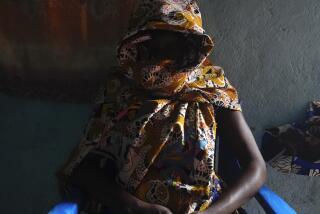Tamil Rebels Surrender Their Weapons : Sir Lanka Arms Turnover to Continue for Days Under Peace Plan
COLOMBO, Sri Lanka — Tamil Tiger guerrillas Wednesday surrendered five truckloads of weapons, ranging from homemade bombs to rusting anti-aircraft cannons, as they began obeying terms of a week-old Sri Lanka-India peace agreement to end the bitter ethnic conflict here.
Dilip Yogi, political commander of the Liberation Tigers of Tamil Eelam, largest and most powerful fighting force in the four-year-old Tamil separatist campaign against the Sri Lankan government, began the process Wednesday afternoon by silently placing his German Luger pistol on a table set up at Palaly air base near Jaffna, the rebel stronghold in the north.
A smiling Sri Lankan defense secretary, Gen. Sepala Attygalle, completed the symbolic exchange by placing his hand on the weapon and giving Yogi a certificate granting him general amnesty.
“This is a historic day for the future of Sri Lanka,” Attygalle said. “It signifies an end to the bloodshed and violence that has affected every fabric of our society.”
Significantly, Tiger commander in chief Velupillai Prabhakaran was not at the surrender ceremony, which was attended by senior officers of the 5,000-strong Indian peacekeeping force now on the island.
In nearby Jaffna, the main rebel stronghold, reporters noted several anti-India posters on walls. “India has betrayed us,” one poster said.
Many of the weapons surrendered Wednesday were old and, in some cases, obviously broken. However, Indian officials, who only the day before were not certain the surrender would take place at all, said they were pleased.
“This is a token gesture,” Indian Lt. Gen. Depinder Singh said. “A beginning.”
The weapons turnover was covered extensively by Sri Lankan radio and television.
Disarming to Continue
Indians said they expect the disarming of the Tamil Tigers to continue for at least another week in the north and in the northeast districts of Sri Lanka, the island-nation of 16 million off the southern tip of India.
Western military experts place the number of Tamil Tigers at about 5,000. Since 1983, nearly 6,000 people have died in the ethnic war in which the minority Tamil population, mostly Hindu, fought to be separate from the majority Sinhalese population, mostly Buddhist.
Despite bitterness over concessions granted the Tamils in the agreement, which was signed by Indian Prime Minister Rajiv Gandhi and Sri Lankan President Junius R. Jayewardene, there has been little antagonism in the Sinhalese community against the Indian military presence on the island, including two Indian warships off Colombo, the capital.
Indian Ambassador J. N. Dixit said 5,000 Indian troops are in the northern peninsula, along with battle tanks, armored personnel carriers and fleets of trucks.
He said no troops have yet been posted in the sensitive eastern district of the island, the area that is to be included in the majority Tamil province to be created under terms of the agreement.
“Our troops are only half an hour away by air if any trouble arises,” Dixit said.
More to Read
Sign up for Essential California
The most important California stories and recommendations in your inbox every morning.
You may occasionally receive promotional content from the Los Angeles Times.










